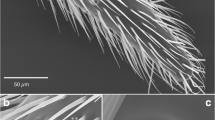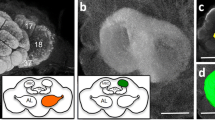Abstract
In insects, the olfactory system displays a high degree of plasticity. In Spodoptera littoralis, pre-exposure of males to the sex pheromone has been shown to increase the sensitivity of the olfactory sensory neurons at peripheral level. In this study, we have investigated this sensitization effect by recording the electroantennographic responses of male antennae to the major sex pheromone component (Z,E)-9,11-tetradecadienyl acetate and to the minor components (Z,E)-9,12-tetradecadienyl acetate and (Z)-9-tetradecenyl acetate. Responses to the conjugated diene acetate at 1 and 10 µg and to the unconjugated ester at 10 µg at three different times (11, 22 and 33 min) after pre-exposure (T = 0 min) were significantly higher than those at T = 0, whereas no increase of sensitivity to the pheromone was elicited by any dose of the minor monoene acetate. In addition, pre-exposed antennae to sub-threshold amounts (0.1, 1 and 10 ng) of the major pheromone component also induced an increased response to the chemical at different times (5 and 15 min) after exposure. Our results revealed that pre-exposed isolated antennae display a short-term higher sensitivity at the peripheral level when compared to naive antennae. In addition, we provide evidence of a peripheral sensitization mediated not only by the major pheromone component, but also by the minor unconjugated diene acetate, and the induction of this sensitivity appears to be dependent on the pre-exposure dose and the time span between pre-exposure and subsequent recordings. Possible implications of the sensitization effect displayed by the minor component for a more effective discrimination of the pheromone bouquets of other closely related species are highlighted.





Similar content being viewed by others
References
Abrieux A, Mhamdi A, Rabhi KK, Egon J, Debernard S, Duportets L, Tricoire-Leignel H, Anton S, Gadenne C (2016) An insecticide further enhances experience-dependent increased behavioural responses to sex pheromone in a pest insect. PLoS One 11(11):e0167469. doi:10.1371/journal.pone.0167469
Acín P, Rosell G, Guerrero A, Quero C (2010) Sex pheromone of the Spanish population of the beet armyworm Spodoptera exigua. J Chem Ecol 36(7):778–786. doi:10.1007/s10886-010-9817-z
Anderson P, Sadek MM, Hansson BS (2003) Pre-exposure modulates attraction to sex pheromone in a moth. Chem Senses 28(4):285–291. doi:10.1093/chemse/28.4.285
Anderson P, Hansson B, Nilsson U, Han Q, Sjoholm M (2007) Increased behavioral and neuronal sensitivity to sex pheromone after brief odor experience in a moth. Chem Senses 32:483–491. doi:10.1093/chemse/bjm017
Anfora G, Frasnelli E, Maccagnani B, Rogers LJ, Vallortigara G (2010) Behavioural and electrophysiological lateralization in a social (Apis mellifera) but not in a non-social (Osmia cornuta) species of bee. Behav Brain Res 206(2):236–239. doi:10.1016/j.bbr.2009.09.023
Bartell RJ, Lawrence LA (1973) Reduction in responsiveness of males of Epiphyas postvittana (Lepidoptera) to sex pheromone following previous brief pheromonal exposure. J Insect Physiol 19(4):845–855. doi:10.1016/0022-1910(73)90156-X
Bernays EA, Chapman RF (1994) Effects of experience. In: Miller TA, van Emden HS (eds) Host-plant selection by phytophagous insects, contemporary topics in entomology, vol 2. Springer, New York. pp 206–229. doi:10.1007/b102508
Binyameen M, Anderson P, Ignell R, Seada MA, Hansson BS, Schlyter F (2012) Spatial organization of antennal olfactory sensory neurons in the female Spodoptera littoralis moth: differences in sensitivity and temporal characteristics. Chem Senses 37:613–629
Burdfield-Steel ER, Shuker DM (2011) Reproductive interference. Curr Biol 21(12):R450–R451. doi:10.1016/j.cub.2011.03.063
Daly KC, Figueredo AJ (2000) Habituation of sexual response in male Heliothis moths. Physiol Entomol 25(2):180–190. doi:10.1046/j.1365-3032.2000.00184.x
Das S, Sadanandappa MK, Dervan A, Larkin A, Lee JA, Sudhakaran IP, Priya R, Heidari R, Holohan EE, Pimentel A, Gandhi A, Ito K, Sanyal S, Wang JW, Rodrigues V, Ramaswami M (2011) Plasticity of local GABAergic interneurons drives olfactory habituation. Proc Natl Acad Sci USA 108(36):E646–E654. doi:10.1073/pnas.1106411108
de Fouchier A, Sun X, Monsempes C, Mirabeau O, Jacquin-Joly E, Montagné N (2015) Evolution of two receptors detecting the same pheromone compound in crop pest moths of the genus Spodoptera. Front Ecol Evol 3:95. doi:10.3389/fevo.2015.00095
Duerr J, Quinn W (1982) Three Drosophila mutations that block associative learning also affect habituation and sensitization. Proc Nat Acad Sci USA 79(11):3646–3650
Dunkelblum E, Kehat M, Gothilf S, Greenberg S, Sklarsz B (1982) Optimized mixture of sex pheromonal components for trapping of male Spodoptera littoralis in Israel. Phytoparasitica 10:21–26
Figueredo AJ, Baker TC (1992) Reduction of the response to sex pheromone in the oriental fruit moth, Grapholita molesta (Lepidoptera: Tortricidae) following successive pheromonal exposures. J Insect Behav 5(3):347–363. doi:10.1007/BF01049843
Gadenne C, Barrozo RB, Anton S (2016) Plasticity in insect olfaction: to smell or not to smell? Annu Rev Entomol 61:317–333. doi:10.1146/annurev-ento-010715-023523
Groning J, Hochkirch A (2008) Reproductive interference between animal species. Q Rev Biol 83(3):257–282
Grubb M, Thompson I (2004) The influence of early experience on the development of sensory systems. Curr Opin Neurobiol 14:503–512. doi:10.1016/j.conb.2004.06.006
Guerrero A, Malo E, Coll J, Quero C (2014) Semiochemical and natural product-based approaches to control Spodoptera spp. (Lepidoptera: Noctuidae). J Pest Sci 87:231–247. doi:10.1007/s10340-013-0533-7
Guerrieri F, Gemeno C, Monsempes C, Anton S, Jacquin-Joly E, Lucas P, Devaud J-M (2012) Experience-dependent modulation of antennal sensitivity and input to antennal lobes in male moths (Spodoptera littoralis) pre-exposed to sex pheromone. J Exp Biol 215(13):2334–2341. doi:10.1242/jeb.060988
Hansson BS (1995) Olfaction in lepidoptera. Experientia 51:1003–1027. doi:10.1007/BF01946910
Kehat M, Dunkelblum E (1993) Sex pheromones—achievements in monitoring and mating disruption of cotton pests in Israel. Arch Insect Biochem Physiol 22(3–4):425–431. doi:10.1002/arch.940220310
Kehat M, Greenberg S, Tamaki Y (1976) Field evaluation of the synthetic sex pheromone, as an attractant for males of the cotton leafworm, Spodoptera littoralis (Boisd.) in Israel. Appl Ent Zool 11(1):45–52
Kromann SH, Saveer AM, Binyameen M, Bengtsson M, Birgersson G, Hansson BS, Schlyter F, Witzgall P, Ignell R, Becher PG (2015) Concurrent modulation of neuronal and behavioural olfactory responses to sex and host plant cues in a male moth. Proc R Soc Biol Sci Ser B 282(1799):20141884. doi:10.1098/rspb.2014.1884
Kuenen LPS, Baker TC (1981) Habituation versus sensory adaptation as the cause of reduced attraction following pulsed and constant sex pheromone pre-exposure in Trichopolusia ni. J Insect Physiol 27:721–726
Legeai F, Malpel S, Montagné N, Monsempes C, Cousserans F, Merlin C, François M-C, Maïbèche-Coisné M, Gavory F, Poulain J, Jacquin-Joly E (2011) An expressed sequence tag collection from the male antennae of the noctuid moth Spodoptera littoralis: a resource for olfactory and pheromone detection research. BMC Genom 12(1):86. doi:10.1186/1471-2164-12-86
Ljungberg H, Anderson P, Hansson BS (1993) Physiology and morphology of pheromone-specific sensilla on the antennae of male and female Spodoptera littoralis (Lepidoptera, Noctuidae). J Insect Physiol 39(3):253–260. doi:10.1016/0022-1910(93)90096-a
Martínez T, Camps F (1988) Stimulation of sex pheromone production by head extract in Spodoptera littoralis at different times of the photoperiod. Arch Insect Biochem Physiol 9:211–220. doi:10.1002/arch.940090305
Merlin C, Lucas P, Rochat D, Francois MC, Maïbèche-Coisne M, Jacquin-Joly E (2007) An antennal circadian clock and circadian rhythms in peripheral pheromone reception in the moth Spodoptera littoralis. J Biol Rhythms 22(6):502–514. doi:10.1177/0748730407307737
Montagné N, Chertemps T, Brigaud I, Francois A, Francois MC, de Fouchier A, Lucas P, Larsson MC, Jacquin-Joly E (2012) Functional characterization of a sex pheromone receptor in the pest moth Spodoptera littoralis by heterologous expression in Drosophila. Eur J Neurosci 36:2588–2596. doi:10.1111/j.1460-9568.2012.08183.x
Mukunda L, Miazzi F, Sargsyan V, Hansson BS, Wicher D (2016) Calmodulin affects sensitization of Drosophila melanogaster odorant receptors. Front Cell Neurosci 10:28. doi:10.3389/fncel.2016.00028
Muñoz L, Rosell G, Quero C, Guerrero A (2008) Biosynthetic pathways of the Egyptian armyworm: an update. Physiol Entomol 33:275–290. doi:10.1111/j.1365-3032.2008.00645.x
Nesbitt BF, Beevor PS, Hall DR, Lester R, Poppi RG (1973) Sex pheromones of two noctuid moths. Nat New Biol 244:208–209
Poitout S, Bues R (1974) Élevage de chenilles de vingt-huit espèces de Lépidoptères Noctuidae et de deux espèces d’Arctiidae sur milieu artificiel simple. Particularités de l’élevage selon les espèces. Ann Zool Écol Anim 6:431–441
Quero C, Lucas P, Renou M, Guerrero A (1996) Behavioral responses of Spodoptera littoralis males to sex pheromone components and virgin females in wind tunnel. J Chem Ecol 22(6):1087–1102. doi:10.1007/BF02027947
Quero C, Vidal B, Guerrero A (2014) EAG responses increase of Spodoptera littoralis antennae after a single pheromone pulse. Nat Prod Commun 9(8):1099–1101
Rankin CH, Abrams T, Barry RJ, Bhatnagar S, Clayton DF, Colombo J, Coppola G, Geyer MA, Glanzman DL, Marsland S, McSweeney FK, Wilson DA, Wu C-F, Thompson RF (2009) Habituation revisited: an updated and revised description of the behavioral characteristics of habituation. Neurobiol Learn Mem 92(2):135–138. doi:10.1016/j.nlm.2008.09.012
Saïd I, Renou M, Morin JP, Ferreira JM, Rochat D (2005) Interactions between acetoin, a plant volatile, and pheromone in Rhynchophorus palmarum: behavioral and olfactory neuron responses. J Chem Ecol 31(8):1789–1805
Saveer AM, Becher PG, Birgersson G, Hansson BS, Witzgall P, Bengtsson M (2014) Mate recognition and reproductive isolation in the sibling species Spodoptera littoralis and Spodoptera litura. Front Ecol Evol 2(18):1–7. doi:10.3389/fevo.2014.00018
Snijders T, Boske RJ (2012) Multilevel analysis: an introduction to basic and advanced multilevel modeling, 2nd edn. Sage Publishers, London
StataCorp (2011) Stata statistical software: release 12. Stata Corp, College Station
Stelinski LL, Gut LJ, Miller JR (2003a) Concentration of air-borne pheromone required for long-lasting peripheral adaptation in the obliquebanded leafroller, Choristoneura rosaceana. Physiol Entomol 28(2):97–107. doi:10.1046/j.1365-3032.2003.00319.x
Stelinski LL, Miller JR, Ressa NE, Gut LJ (2003b) Increased EAG responses of tortricid moths after prolonged exposure to plant volatiles: evidence for octopamine-mediated sensitization. J Insect Physiol 49(9):845–856. doi:10.1016/S0022-1910(03)00136-7
Tamaki Y, Yushima T (1974) Sex pheromone of the cotton leafworm, Spodoptera littoralis. J Insect Physiol 20:1005–1014
Acknowledgements
We gratefully acknowledge MINECO for financial support (project AGL2015-66469-R) with assistance from the European Regional Development Fund.
Author information
Authors and Affiliations
Corresponding author
Rights and permissions
About this article
Cite this article
López, S., Guerrero, A., Bleda, M.J. et al. Short-term peripheral sensitization by brief exposure to pheromone components in Spodoptera littoralis . J Comp Physiol A 203, 973–982 (2017). https://doi.org/10.1007/s00359-017-1205-5
Received:
Revised:
Accepted:
Published:
Issue Date:
DOI: https://doi.org/10.1007/s00359-017-1205-5




